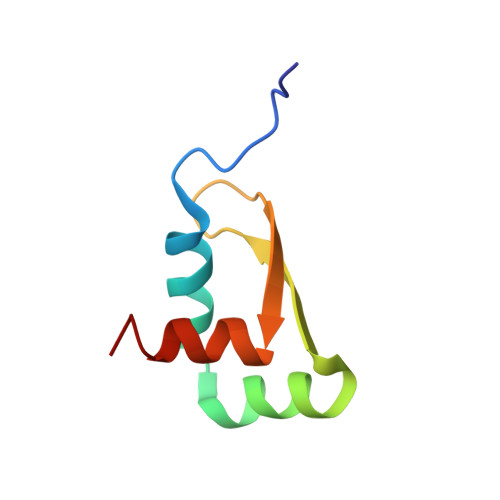The Zinc-dependent Redox Switch Domain of the Chaperone Hsp33 has a Novel Fold
Won, H.S., Low, L.Y., De Guzman, R.N., Martinez-Yamout, M.A., Jakob, U., Dyson, H.J.(2004) J Mol Biology 341: 893-899
- PubMed: 15328602
- DOI: https://doi.org/10.1016/j.jmb.2004.06.046
- Primary Citation of Related Structures:
1XJH - PubMed Abstract:
The Escherichia coli chaperone Hsp33 contains a C-terminal zinc-binding domain that modulates activity by a so-called "redox switch". The oxidized form in the absence of zinc is active, while the reduced form in the presence of zinc is inactive. X-ray crystal structures of Hsp33 invariably omit details of the C-terminal domain, which is truncated in protein constructs that are capable of forming crystals. We report the solution structure of a recombinant 61-residue protein containing the zinc-binding domain (residues 227-287) of Hsp33, in the presence of stoichiometric amounts of Zn2+. The zinc-bound protein is well folded, and forms a novel structure unlike other published zinc-binding domains. The structure consists of two helices at right-angles to each other, a two-stranded B-hairpin and a third helix at the C terminus. The zinc site comprises the side-chains of the conserved cysteine residues 232, 234, 262 and 265, and connects a short sequence before the first helix with the tight turn in the middle of the B-hairpin. The structure of the C-terminal zinc-binding domain suggests a mechanism for the operation of the redox switch: loss of the bound zinc ion disrupts the folded structure, allowing the ligand cysteine residues to be oxidized, probably to disulfide bonds. The observation that the C-terminal domain is poorly structured in the active oxidized form suggests that the loss of zinc and unfolding of the domain precedes the oxidation of the thiolate groups of the cysteine residues, since the formation of disulfides between distant parts of the domain sequence would presumably promote the formation of stable three-dimensional structure in the oxidized form.Hsp33 provides an example of a redox signaling system that utilizes protein folding and unfolding together with chemical modification for transduction of external stimuli, in this case oxidative stress, to activate the machinery of the cell that is designed to deal with that stress.
- Department of Molecular Biology, The Scripps Research Institute, La Jolla, CA 92037, USA.
Organizational Affiliation:

















